Discover Ba Ria-Vung Tau – Vietnam's Riviera
If anywhere in Vietnam could be described as the "Vietnamese Riviera," it would surely be Ba Ria-Vung Tau. Below are the top destinations in this southern province:
Vung Tau City
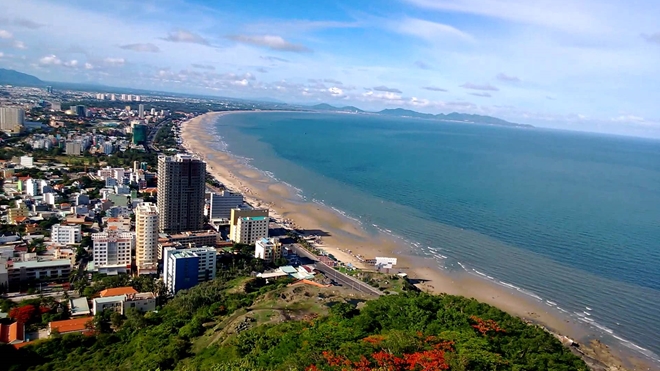 |
Vung Tau is HCM City’s closest beach resort, and can be reached by a picturesque hydrofoil ride down the Saigon River or by a rather circuitous highway route. Those suffering from burn out during an extended stay in Ho Chi Minh City will enjoy Vung Tau during the week.
To most tourists, Vung Tau is one of the most interesting destinations and loved for its extensive beaches. Tourists always prefer sightseeing at Front Beach (Bai Truoc) and going swimming in Back Beach (Bai Sau).
The first beach is front beach, in the West of the city, where the sun goes down. The Front Beach is considered the facade of Vung Tau city. It is also called by other names such as Tam Duong beach or Hang Dua bay. Besides the best location, the beach is also preferred for having many restaurants and elegant hotels. Sparking, colorful and bright light boulevard make the Front Beach more beautiful.
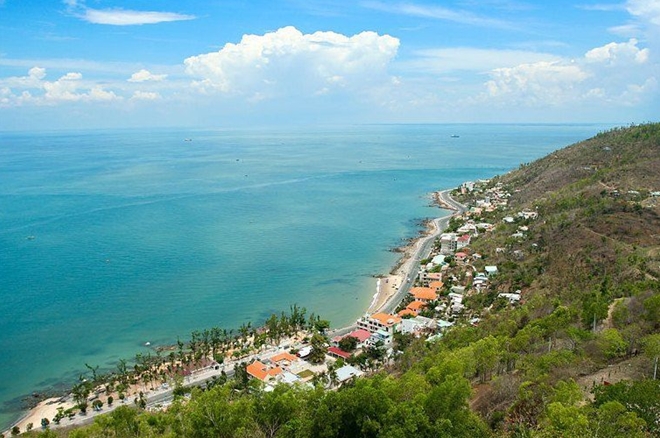 |
| Bai Chuoc beach. |
Opposite to the Front Beach is Back beach (Thuy Van beach or Bai Sau in Vietnamese). Back Beach is well-known for its over 10 kilometers of fine sand seaside. The beach is busy with tourists both from the city itself and the world. At weekends or on holidays, thousands of people often come here for swimming and entertainment.
Other beautiful beaches are Pineapple Beach (Bai Dua) and Mudberry Beach (Bai Dau).
From the Front Beach, Ha Long Street curls to the Pineapple Beach. The name began a long time ago, when the beach had many pineapple trees. Many Vung Tau people also call the beach Lang Du, which originated from the first restaurant’s name.
Right here, the sea goes far into the land and the rock mountain goes from the land to the sea establishing hidden small beaches. Nearby, the Temple of Southern sea Saint and Tinh Xa nirvana are attractive tourist sites, built on one of these rock mountains.
Sights of interest in Vung Tau
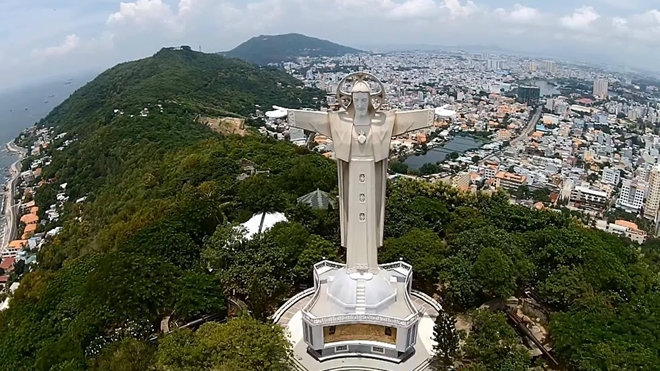 |
Jesus statue, standing at the top Nui Nho mountain, was built by the Vietnam Catholic Association in 1974 and completed in 1993. It is 32 meters high, standing on a 4-meter platform with two outstretched arms spanning 18.3 meters. Visitors can climb up a 133-step corkscrew staircase inside the statue to enjoy the whole view of Vung Tau.
Bach Dinh (White Palace), built by the French (1898-1916) as a summer holiday house of French Governor General Paul Doumer, named Villa Blanche after his favorite daughter’s name. Villa Blanche is located on the slop of Nui Lon (Big Mountain), along Tran Phu Street, at 50m above sea level.
From its balcony there's a panoramic view of Front Beach and opposite the Villa at the foot of that mountain is Hai Nguu islet with a stone rock shaped like a water buffalo wallowing in water.
Next to Hai Nguu at the seaside was the helicopter yard. Today Villa Blanche exhibits hundreds of antiques collected from Cau Islet - Con Dao and is a cultural destination that attracts hundreds of tourists every day.
Thich Ca Phat Dai pagoda, located on the northern slope of Nui Lon Mountain, built between 1961 and 1963, is set on a plot of around five hectares, with a Zen Buddhist monastery at the foot of the plot and a giant statue of Buddha in white cement sitting on a large lotus blossom at the top. The pagoda is famous as it lies in the harmonious combination between the natural surroundings and the architectural structure.
Niet Ban Tinh Xa, also known as Chua Phat Nam or the Pagoda of the Lying Buddha, is 3 km from town and sits on the side of Nui Nho Mountain facing the ocean.
Work began on the pagoda in 1969 and was completed in 1974. This is probably the most beautiful pagoda in Vung Tau for its many intricate architectural details and the granite work around the pagoda.
There is a flag tower standing 21 m high in front of the temple covered by ceramic tiles. Perched atop the tower is a Lotus, signifying Buddhist purity.
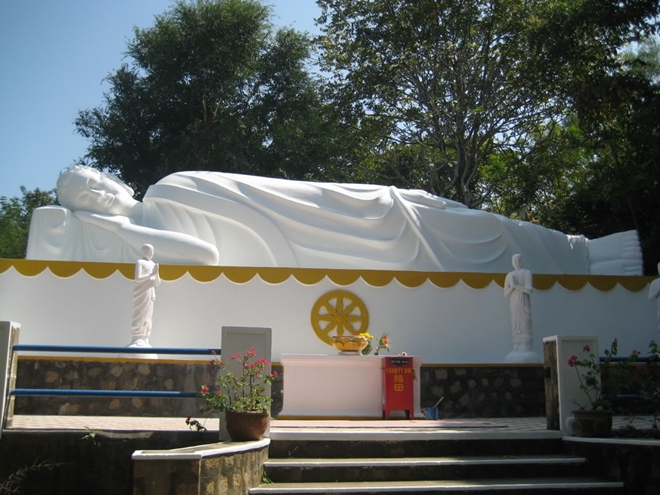 |
There are 42 steps leading to the Lotus signifying the first 42 pages of the Buddhist Sutra which made their way to Vietnam in the 2nd century.
The main area of the pagoda is built in the likeness of the garden in which Buddha entered Nirvana. Here lies a 12 m statue of Buddha overlaid with marble.
The gate of the garden is guarded by two gods, Ong Thien (God of Goodness) and Ong Ac (God of Evil). Standing in wait below the sleeping Buddha is the likeness of his closest disciples.
To the rear of the temple is the boat Bat Nha built of concrete to signify Buddhism as a craft in which mankind can escape Be Kho or Sea of Sorrow. In the upper level hangs the giant bronze bell Dai Hong Chung 3.5 m high and weighing 3.5 tons.
Con Dao Archipelago
Con Dao is the biggest archipelago in Ba Ria- Vung Tau province, and is an ideal destination for those who are nature lovers. This archipelago contains 16 islands with the total size of 76 square kilometers, and the largest among them is Con Lon Island.
Tourists can experience nature, museums, pagodas, markets and statues. Con Dao is definitely a must - see attraction in Vung Tau as it has natural and stunning beauty.
First of all, for those who are nature lovers, you can visit Con Dao National Park and Dam Trau Beach. Con Dao National Park is a diverse ecosystem and has many species of corals and sea turtles.
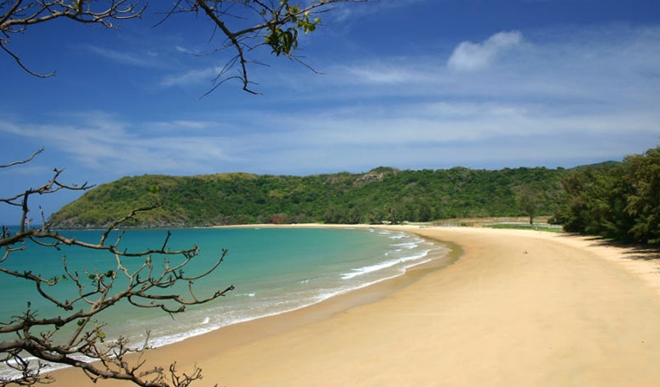 |
The park covers fourteen of sixteen islands and their surrounding marine area. Visiting the park, visitors have a chance to discover the undersea world with many pieces of animals and plants in different colors and shapes.
It is the home to 882 species of floral species, 135 species of animals, and more than 1300 species of marine creatures. Besides it, Con Dao National Park is the favorable habitat of rare animals such as Hawksbill, Green Turtle and Dugong.
There are many rare animals and plants inhabiting the park and it contributes to make the diversity of the park. Coming to Dam Trau Beach, visitors will have a chance to enjoy the atmosphere and activities on the beach.
Tourists can go to visit Van Son pagoda in Con Dao. The pagoda was built to meet the spiritual needs of residents and visitors who wish to worship.
Tourists can also visit Con Dao market. Coming here, you will find fresh vegetables and food stalls of local specialties, small garments, toiletries and others.
Furthermore, it will be regretful if you miss the chance to enjoy special foods in Con Dao such as Mini Savory Pancakes, Can cake, Shredded Duck Porridge and Salad, etc... These foods are featuring dishes in Con Dao in particular and Vung Tau. You also can taste these dishes when travelling to Con Dao.
In the center of Con Dao, there are streets with lines of ancient tropical almond trees. After being used as a place of lords of island to live and work for 113 years, the ancient house built in the period of French domination has become the showroom of historical monuments of Con Dao from Vietnam travel agency.
Hang Duong cemetery is the resting-place of over 20 revolutionary soldiers with names or without names. This may be the only cemetery where the tombs are designed simply: each tomb is a small rectangular rock pillar, above the tomb is a brown brick with a star.
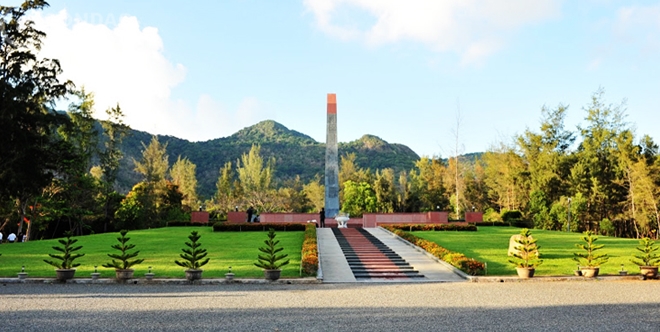 |
The tomb of Vo Thi Sau martyr that is in the B area is spiral with incense smoke. Annually, when the anniversary of her death comes, people come here to worship her.
Con Dao is also famous for the primitive and beautiful beach like Dam Trau, hang Duong, Phi yen… sand on the beach is very smooth and seawater is clean. The Con Dao rocky mountains with the sea makes an attractive landscapes: Mui ca map, Thanh Gia mountain, Tinh yeu top of mountain…surrounding Con Son (the main island of Con Dao) is small islands: Hon Cau, Hon Bay Canh, Hon Trung, Hon Tre… and blue bays: Ben Dam bay, Dam Trau Bay, Dam Tre bay…
Bai Nho is not far from charming Dam Trau bay. Right here, after swimming, we climbed the cliffs, visiting the primitive lake of fresh water behind the bay, and diving to see colorful coral reefs and flocks of fish. Then, we wandered in the primeval forests, seeing rare animals only in Con Dao like Nicoba doves…
Coming to Con Dao, do not forget to visit the shrine of Phi Yen – Nguyen Phuc Anh lord’s wife.
For these reasons, Con Dao will satisfy your wish to travel and admire the beauty of nature.
Con Dao Prison
 |
Con Dao is notable for its paradoxes, one of very few “Hell on Earth”, the Con Dao prison, and wonderful natural scenery with the ocean, mountains and grass field. Thiscombination: the beauty of nature and the evil of humans.
The noted place in Con Dao is Con Dao prison – the place that jailed prisoners in the Vietnam War. Compared to Phu Quoc prison, Con Dao prison was behind in terms of torturing methods, but it is well-known for a much longer history.
Established in 1862 by French Colonists, Con Dao is known as a Hell on Earth; anyone arrested there would suffer a painful death.
From 1862 to 1975, Con Dao captured and detained thousands of prisoners, mostly patriots. Con Dao prison conjures up a dark memory that makes everyone trembling when reminded of the past.
In Con Dao, the French Colonists and American Army built a system of torturing, beating and killing prisoners slowly and painfully. They established special departments to easily torture prisoners.
The most famous one is separate “tiger cages”, which shocked the American public in 1970s, with unbelievable methods applied to prisoners. These tiger cages are small basements built with stone with steel window on the top, with the aisles between basements for jailers and soldiers to guard and insult prisoners with dirty water and lime.
Jailers even invented “sunbathing room”, known as the tiger cages with no roof to force people inside to suffer from the sun heat for days. Another noted invention is separate cow sheds, which had been used to keep cows inside, but jailers transformed them into rooms for prisoners. They kept prisoners among animals in very poor conditions.
More terribly, they sent some “dangerous” prisoners to the basements under the sheds and let them rot away due to the excrement from the animals. Prisoners here were chained with cuffs all the time, and the food was just enough for them to survive. The jailers beat prisoners whenever they wanted, and kept inventing torturing methods that could not be seen anywhere else, including taking teeth, nailing into body, burning, etc.
Con Dao nowadays has become an uncomfortable museum for people to visit, but it still attracts many tourists to witness the evilness of humans. It could be a useful and interesting history lesson for all tourists.
Suoi Da (Rock Stream)
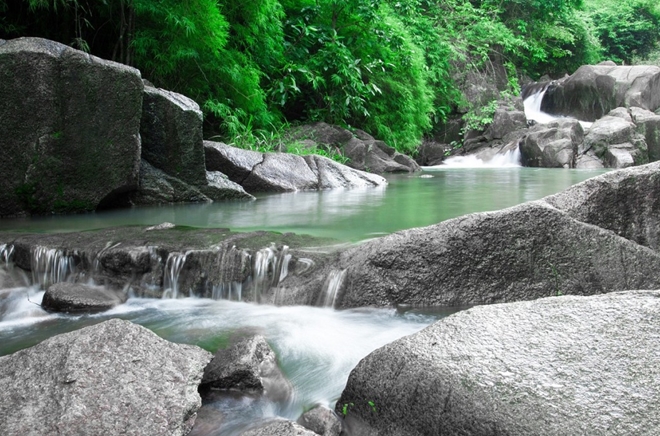 |
Tourists should not ignore the poetic beauty of Suoi Da (Rock Stream) which begins at Dinh Mountain in Tan Thanh District, Ba Ria-Vung Tau Province.
Those coming here will be impressed by this destination where there are many rocks of various sizes lying on the banks, forming into many smaller waterfalls. Tourists can rest on big and smooth rocks as they relax and admire the wonders of nature and talk with friends.
Locals say that from the foot to the peak of the mountain, there are five lakes that they number from 1 to 5. In scorching summer days or weekends, visitors flock to the lakes to swim in the cool water. Some young boys often jump from the mountain wall to the lake at a height of two meters and amidst the white bubbles they laugh as they revel in the joyous relationship between nature and humans.
Suoi Da is still non-residential so tourist services consist of small cottages to rest and enjoy food. Some vendors also come to sell snacks and drinks.
The ideal time to come to the stream is around 9 a.m. After swimming, tourists can take a rest and then have lunch. Later they can walk on the rocks along the stream as they bid to trek up the mountain. There are many old pagodas for tourists to visit on the way up.
Binh Chau hot spring
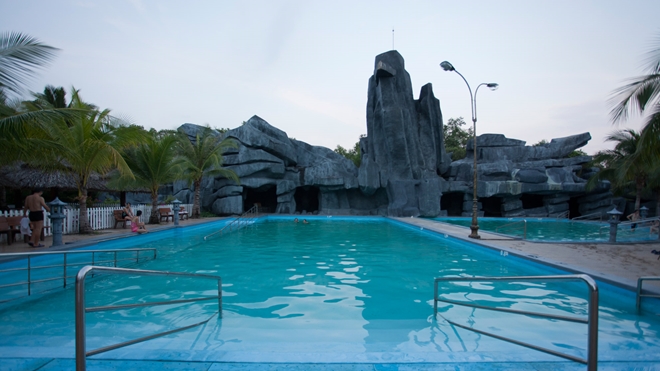 |
About 150km from Ho Chi Minh City, Binh Chau Hot Springs, in Xuyen Moc District's Bung Rieng Commune, covers an area of about 33ha, enclosed by forest and sea.
In 1928, a French doctor named Sallet discovered the hot mineral spring in his survey of southern Vietnam, where a cluster of 70 visible gushers spout water at temperatures ranging from 40oC to 82oC, forming a huge natural pool of hot water and mud.
With a view to develop a tourist attraction, province began to develop the Binh Chau Hot Mineral Springs in 1988, and their efforts were recognized in 2003, when the World Travel Organisation named Binh Chau as one of its 65 sustainable eco-tourism developments in 47 countries and territories around the world.
Walk on the wooden corridors through the flowing springs of the Sai Gon-Binh Chau Resort, and you can feel the stimulating atmosphere of fresh air laced with steam and the fragrance of the forest underneath the leafy canopy. The view is miraculous in the morning, as the steam covers the natural scenery in a thin dew.
The resort includes sports and recreation facilities for tourists on weekends, such as golf, volleyball, a swimming pool, a romantic Moon Garden and a thousand-seat theatre. Crocodile feeding, river fishing, billiards, tennis, basketball, and badminton complete the card at the Sai Gon-Binh Chau Resort, and younger visitors can visit the children's playground.
In the vicinity of Binh Chau, tourists can travel by foot or wagon to Bang Spring, about 2km away, or visit the zoo with its menagerie of bears, monkeys, weasels, geckos and eagles.
Most tourists who come to Binh Chau enjoy the fun of boiling eggs in the natural 80-degree springs in just ten minutes. Guests can buy eggs and lower them into small hot pools built by the developer for the purpose.
After the fun with the eggs, there are hot mud baths, soaks and massage services that are all therapeutic. According to researchers who tested the springs in 1975, the hot mineral spring source contains silica, sulphur, sodium and chlorine, all of which have healing properties and can aid rheumatism and circulation.
Legend describes the thermal springs as a hot water pot that the Vietnamese "Goddess of Boiling Water" spilled into the place in anger after her husband went hunting and was a long time returning. She got angry and threw the boiling water pot away, and it became the marvelous stream of hot water still running now.
Binh Chau area is also a wonderful place to hold retreats and team-building activities.
As the curtain of night covering Binh Chau fall, geckos and crickets begin their symphony on a stage of forest and mountains.
Monkey pagoda
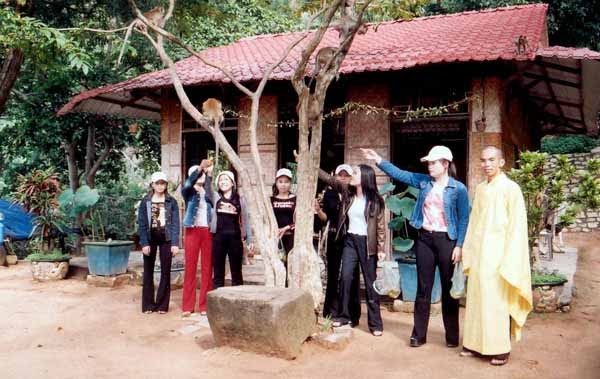 |
Monkey pagoda lies at the bottom of Ky Van Mountain, belongs to Long Hai Town, Long Dien District, Ba Ria - Vung Tau Province. Besides natural beauty, there are monkeys, raised in the natural environment on the Ky Van mountain behind the pagoda.
The pagoda is named Nguyen Chon Monastery. Because of its raising many monkeys, it is known as the Monkey pagoda. These smart animals usually live wildly in the mountains.
Over 10 years ago, Abbot Thich Thong Luan treated some monkeys and after getting acquainted, they began going down the mountain every day. At first the number was not much, but it is now up to nearly 200.
Tourists come here and often bring bananas and other fruits to feed the monkeys before seeing landscape.
Stand out among thousands of green trees, the rock masterpiece from the tectonic nature is interesting.
A rock shaped “snake holds gem in mouth” is a symbol of prosperity, a large rock shaped like the Buddha statue reminds of peace there are also a hundred year old tree, and rock cave. .
In spring, the road from Long Hai town is filled with pink and white peach blossoms.
Fairy Stream
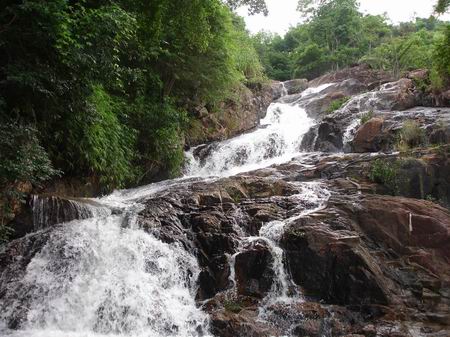 |
About 7 kilometers North-West of Ba Ria Town and originating from Dinh Mountain of nearly 500m-height, the Fairy Stream located in Tan Thanh district is called “the second Dalat in Vietnam” for its beautiful natural landscape.
Accompanied by a legend of the past, fairies would come here to bathe before returning to heaven. The trace of a delicate foot print, in a rock on a peak of Dinh Mountain, may have initiated this legend.
From hundreds of meters high, the Fairy Stream falls down the rocky mountain, and irrigates fields before dissolving in Thi Vai River.
The Fairy Stream has natural and pristine beauty.
Along both banks of the stream are large and even rocks which tourists can sit to rest on or enjoy the view. In addition, there are many granite stones covered with moss and lichen.
More especially, tourists hear the sound of the stream falling from the top of mountain and forming rather deep wells with blue water. The stream has white spume in the rainy season but becomes the ideal place for swimming in the dry season.
Getting to the Fairy Stream, tourists should go along trail to visit small pagodas, hear sound of pagoda bell and smell incense mingled with fragrant perfume of tuberose and magnolia.
Long Phuoc tunnel
 |
Long Phuoc tunnel is located at Long Phuoc commune, Ba Ria town (Ba Ria – Vung Tau). Because of military political and economic important strategic position, Long Phuoc was always a fiercely disputed area between Vietnam and enemies during the two resistance wars against the French colonialists and US imperialists. Throughout the years of fierce wars, a unique and famous tunnel system was created here under the leadership of the Communist Party.
Starting the movement of secretly tunnel digging at Mr. Nam Hoi’s house in 1948, the tunnel system is in all five hamlets in the commune: East hamlet, West hamlet, South hamlet, North hamlet and Phuoc Huu hamlet.
These tunnel clusters are interconnected by spine route, with secret tunnel containing reserved food with the fighting fortifications. Spine tunnel is 2-3m away from the ground, tunnel lap is 1.5-1.6 meter high and 0,60-0,70 meter wide, ensuring easy to move. The tunnel in East hamlet is over 360 meter long, having many fighting fortifications, first aid stations, weapon and food depots.
In April 1963, the tunnel was restored and developed into a solid, uninterrupted condition. The tunnel was dug 6 meters deep more, spine route was extended 0.70-0.80 meter more, 1.6-1.8 meter high with many doors, vents and fighting emplacements.
Through the 27-year development of the resistance war against French colonialists and the anti-American resistance war (1948-1975), Long Phuoc tunnels were always an important place where revolutionary forces clung valiantly against enemies.
The typical example is the battle from March 5 to April 11, 1963 against the enemy sweeping in Long Phuoc, guerrillas and local soldiers eliminated 243 enemies and destroyed 12 M113.
Under enemies’ fierce repeated attacks, Long Phuoc tunnel stood firm in the face of difficulties, considered as a worthy land – an important foundation to nurture the revolutionary movement of Ba Ria – Vung Tau province.
Therefore, on the date of 1/9/1990, the Ministry of Culture – Information recognized Long Phuoc tunnel a national level historical monument. Since then, Ba Ria – Vung Tau General Museum has been restored and embellished twice Long Phuoc tunnel relic to serve visitors and maintain traditions for young generations. Ba Ria town has recently invested billions to build Long Phuoc martyr temple which is next to the relic, as a public recognition for people who sacrificed for homeland.
Thang Tam communal house
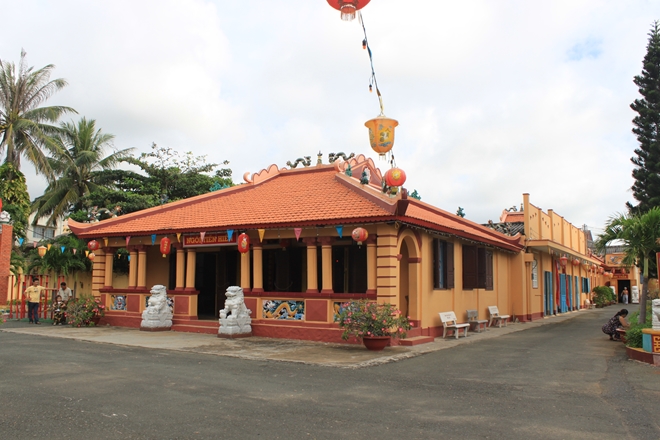 |
Thang Tam communal house has a unique architecture and expresses the cultural characteristics of coastal fishermen, but it still has the general characteristics of Vietnam village.
According to historic records, this communal house was built under the reign of Emperor Minh Mang (1882-1840). The communal house still reserves ̣two titles conferred by the Nguyen Dynasty to the spirits worshipped at the communal house.
Thang Tam communal house has Tam Quan Gate, Tien Hien House, the Hall and Dinh Trung Throne, and performance stage for fighting art.
In the house, there are a lot of offerings which are engraved tactfully and red-lacquered. Thang Tam communal house has serial architecture, consisting of a house terrace with four houses connected together by a side pathway.
Besides historical and cultural value, Thang Tam communal house is also the place of many folk traditional festivals.
Long Son fishing village
Coming to Long Son fishing village, Ba Ria – Vung Tau province, tourists will have a chance to turn into a fisherman, catch fish and enjoy fresh seafood.
In order to arrive at the fishing village, tourists have to spend 10 more minutes going by boat. The restaurants in Long Son village are impressive with cages full of fish, shrimp and crab.
After giving the order, customers can directly choose seafood from these cages. There are both rustic dishes and specialties of the Southern Vietnam here such as: barnacle coming with mustard, fish grilled with pepper and salt, grill crab, crab with tamarind, Long Son crab, hot pot, steamed fish, etc. Girls in Vietnamese silk pajamas (“áo bà ba” in Vietnamese) with suntanned skin are very considerate toward customers. Therefore, customers feel close and friendly.
The village is not only famous for its delicious dishes but also interesting experiences. Tourists can turn into fishermen and catch fish in the estuary of Rang River. Catching fish here is not too difficult, tourists just need to drop cages into the river and wait until fishes fall into your trap.
The flocks of fish often gather near the fish cage in order to eat leftover food. Therefore, this estuary is an ideal place for people who like fishing.
Long Son fishing village is one of tourist attractions in Ba Ria – Vung Tau. It attracts thousands of visitors every month. However, not many people know that the fishing village was built by a poor and poorly educated fisherman. That man is Mr. Ly Buu Hoi. Although he now has become very rich, he is still simple and plain like other fishermen in the village. Everyone admires and loves him due to his sociability and kindness.
Dinh Mountain
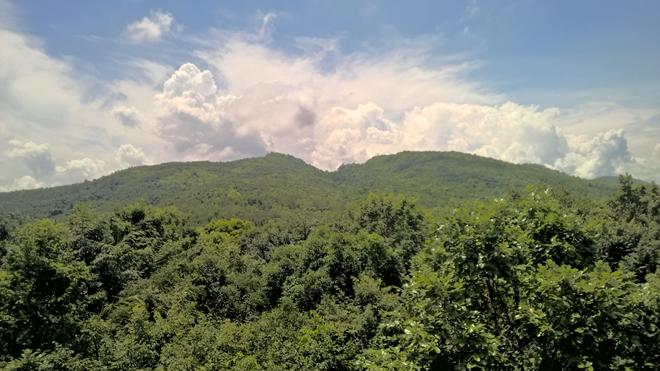 |
Dinh Mountain spreads through Long Huong Commune (Ba Ria City), Chau Pha and Hoi Bai communes (Tan Thanh District). On this mountain, the big stones with quaint shapes seem to extend an invitation to visitors. Dinh Mountain has plenty of caverns as Mai Cavern, To Cavern, Doi Cavern... Standing on the top of this mountain, tourists can get a panoramic view of the immense sky and sea as well as the green mangrove forests, canals, shrimp farms, salt fields and the hamlets together with new urban areas.
Binh Chau – Phuoc Buu Nature Reserve
The nature reserve is home to many kinds of animals and plants, including those in danger of extinction. The coastal protective forest here was planted to protect natural landscape and to meet people‘s a research and learning demand. This area has been developed into an ecotourism area, which attracts thousands of visitors every year.
Binh Chau – Phuoc Buu is the only coastal primeval forest in the Southeastern region and also in Vietnam travel. Most coastal forests are mangrove ones. However, most of the trees here are broad-leaf trees, specifically dipterocarpaceae which grow on barren soil. The reserve comprises a diverse floristic composition with nearly 200 kinds of plants representing 732 varieties of higher plants, 14 of which are precious and rare, such as “cẩm Iai”, “gỗ đỏ”, “gỗ mật”, “giáng hương”, “bình linh nghệ”, “dầu cát” and “kơ-nia”. The peaceful forests are also home to hundreds of species of animals, including insects, amphibians, reptiles, birds and so on. There are 34 species of precious and rare animals listed in the Vietnam’s Red Data Book here.
Minh Dam Base
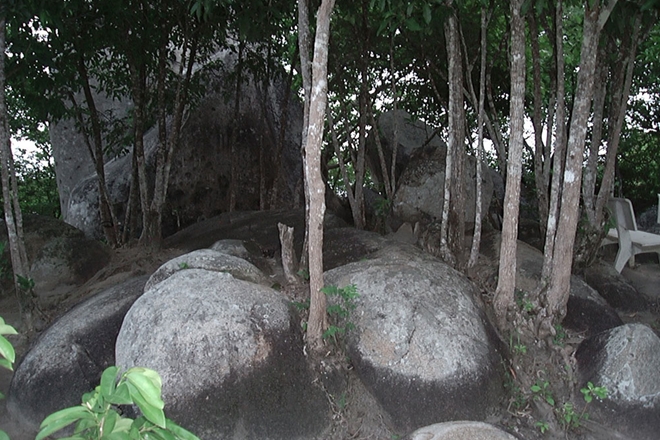 |
Minh Dam Base located in Minh Dam Mountain includes 4 main units: Da Che, Chua Gieng Gach, Chau Vien and Da Giang. It was used as a revolutionary base for the struggle against French colonial and American imperialist from 1948 to the beginning of 1975.
Compiled by Pha Le
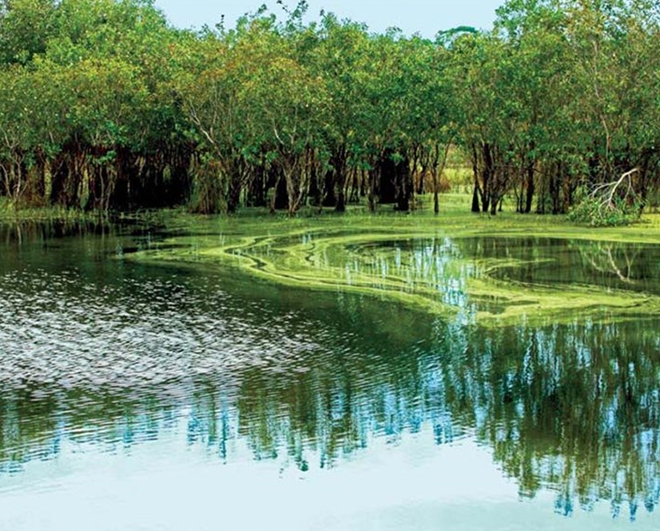 |
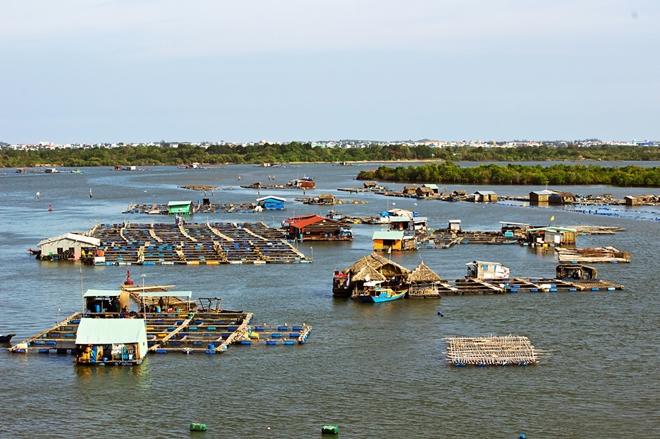 |

